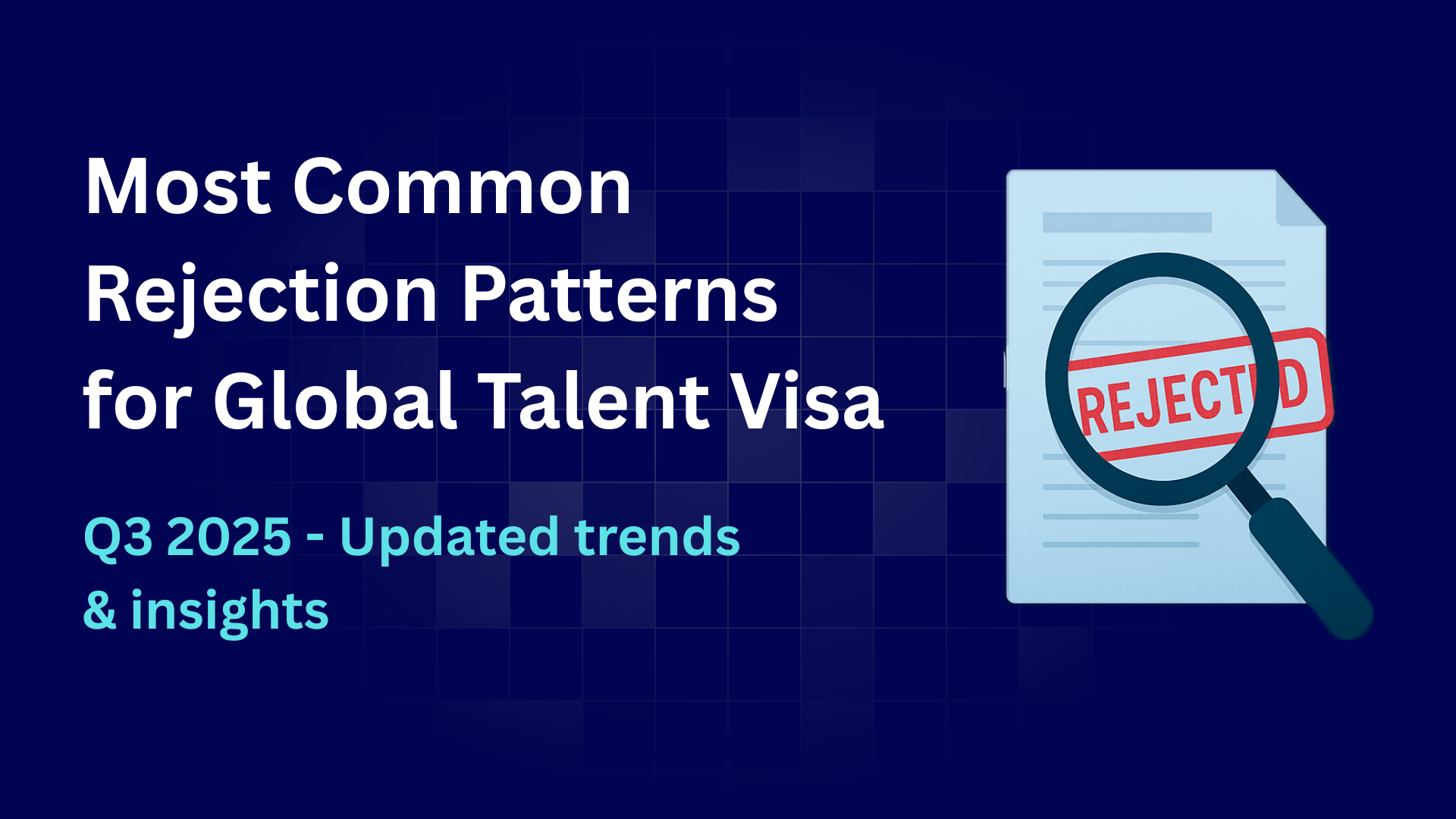Most Common Rejection Patterns for Global Talent Visa in Q3 2025 - Updated
Here are the 6 new rejection patterns catching applicants off guard.

The Global Talent Visa landscape has shifted dramatically in recent months, with Tech Nation assessors implementing stricter scrutiny processes that are catching even experienced applicants off guard. After analyzing the latest rejection feedback from July-September 2025, six critical new patterns have emerged that are fundamentally changing how applications are evaluated.
These aren't minor adjustments to existing criteria - they represent a fundamental shift in how Tech Nation verifies authenticity, measures individual impact, and defines what constitutes a "product-led digital technology company." Understanding these evolving standards is crucial for anyone preparing their application in late 2025.
1. Digital Signature Authentication and Letter Verification
The authentication of recommendation letters has become significantly more rigorous, with assessors now conducting forensic-level scrutiny of digital signatures and letter authenticity.
Digital signature inconsistencies trigger authenticity concerns. Assessors are now identifying when recommendation letters show signs of being processed through the same digital signing workflow or contain identical signature formatting patterns. This raises questions about whether applicants coordinated the letter creation process inappropriately.
Missing audit trails disqualify letters entirely. Assessors now expect complete digital signature verification paths. Letters without proper audit trails are flagged as potentially inauthentic, regardless of content quality.
Template detection has become sophisticated. Multiple rejections now explicitly state "the use of templating is evident in many of the letters of support and recommendation." Assessors can identify when letters follow similar structures, use comparable language patterns, or contain recycled phrases across different referees.
The solution isn't just avoiding templates - ensure each letter writer uses their own authentic voice, personal anecdotes, and unique perspectives on your work. Consider having letters written on different platforms or word processors to avoid formatting similarities.
2. Individual vs. Team Contribution Verification
Assessors are now demanding granular proof of individual impact, moving beyond accepting broad team achievements as evidence of personal exceptional talent.
Team outcomes require individual attribution. Recent feedback explicitly states: "The fundraising outcomes are the result of a team effort, and cannot be attributed solely to the applicant's individual work." Generic claims about being part of successful teams no longer suffice.
Metrics must be personally traceable. Assessors want to see specific evidence of what YOU accomplished versus what your team achieved. Product metrics, revenue growth, or user acquisition numbers must be directly connected to your individual contributions with clear before/after comparisons.
Third-party verification of personal impact is essential. Self-authored evidence about individual contributions is heavily discounted. Assessors specifically state they "need to see third party and external evidence to corroborate the applicant's claims from persons who are not colleagues or employers."
Document your individual contributions with timestamped commits, personal project ownership records, and specific testimony from external stakeholders about your unique role.
3. Award and Recognition Authenticity Standards
The bar for what constitutes meaningful recognition has risen dramatically, with assessors now investigating the credibility and significance of awards and media coverage.
Award recipient volume matters more than award names. Assessors now note when there are "very large number of other award winners at the same time," indicating that awards with numerous simultaneous recipients carry less weight. Exclusive recognition carries significantly more value than participation awards.
Media outlet credibility is deeply scrutinized. Rejections specifically mention that certain media outlets "do not constitute notable digital technology industry recognition on a national or international level." Generic news sources are distinguished from specialized technology publications.
International recognition requires global impact proof. Claims of international recognition must be backed by evidence of global reach, circulation numbers, and demonstrated impact beyond local or regional significance.
Focus on exclusive recognitions, specialized technology media coverage, and awards with rigorous selection processes rather than participation-based recognition.
4. Product-Led Digital Technology Company Classification
The definition of what qualifies as a "product-led digital technology company" has become far more restrictive, with many traditionally accepted companies now disqualified.
Consulting and services firms are explicitly excluded. Recent rejections state "Tech Mahindra is not eligible as this is an IT services and consulting company, not a product-led one." This extends to any company primarily focused on client services rather than proprietary product development.
Business consultancies don't qualify regardless of tech involvement. Even companies using advanced technology are disqualified if their primary business model involves consulting, outsourcing, or providing services to other businesses rather than developing and selling their own products.
Product-led means direct consumer or business products. Assessors are now strictly interpreting this to mean companies that develop, own, and distribute their own technology products directly to end users or businesses.
Before applying, carefully evaluate whether your employer truly qualifies as product-led. If questionable, focus evidence on side projects, open-source contributions, or previous roles at clearly product-focused companies.
5. Career History Completeness and Consistency
Assessors are now conducting comprehensive background verification, cross-referencing multiple data sources to identify inconsistencies or gaps in career narratives.
Complete career timeline verification is mandatory. Rejections cite cases where "the applicant's CV as provided along with his LinkedIn profile go back only as far as February 2020 leaving many years of the applicant's career track record unaccounted for."
Cross-platform consistency is verified. Assessors compare information across LinkedIn, company websites, CV submissions, and public records. Any discrepancies raise credibility concerns about the entire application.
Employment status disclosure must be complete. Failing to properly disclose freelance work, consultancy arrangements, or business ownership leads to credibility loss. One rejection specifically noted the applicant "does not anywhere mention that the job roles he describes have been undertaken as a freelance/outsourced resource."
Ensure your CV, LinkedIn, and application tell identical stories with no unexplained gaps. Be transparent about employment arrangements, including freelance, contract, or consultancy work.
6. Innovation and Sector Advancement Evidence Requirements
The standard for proving innovation and sector advancement has become substantially more demanding, with assessors requiring concrete evidence of field-wide impact.
Academic research roles face heightened scrutiny. Assessors now explicitly state that research positions are "not typical for an ET awardee, due to little experience in digital technology," even for highly cited academic work. Pure research contributions require clear digital technology application.
Industry-wide recognition must be demonstrable. Assessors consistently note when evidence shows "expertise but does not constitute a significant, field-advancing contribution." Technical competence alone is insufficient - you must prove you've changed how others in the field operate.
Innovation requires measurable adoption or impact. Claims of innovation must be supported by evidence of adoption by others, changes in industry practices, or measurable impact on the broader technology ecosystem.
Focus on contributions that others have adopted, cited, or built upon rather than personal technical achievements without broader impact.
Strategic Response to These Changes
To succeed under these heightened standards:
- Audit your letter authenticity by ensuring each referee uses their own writing style and avoids any template-like language or structure.
- Document individual contributions with timestamp evidence, personal project ownership, and external verification of your specific role in achievements.
- Verify company classification rigorously. If your employer's product-led status is questionable, focus evidence elsewhere.
- Ensure complete career transparency across all platforms and documents with no gaps or inconsistencies.
- Emphasize external impact over internal achievements, showing how your work has influenced others in the field.
- Gather third-party verification from independent sources who can authenticate your contributions without conflicts of interest.
The Global Talent Visa remains achievable, but the authentication and verification standards have fundamentally shifted. Success now requires not just exceptional talent, but also meticulous documentation and external validation of that talent through credible, independent sources.
Need expert guidance navigating these updated requirements? Schedule a consultation to ensure your application meets the new authentication standards.
